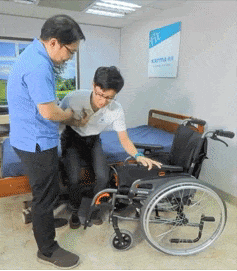The core strength of the wheelchair user will determine the method in which they are transferred to a wheelchair. The methods described are suitable for those with elderly caregivers as they adhere to a “no-lift policy” which means there is strictly no lifting the wheelchair user for wheelchair transfers.
To help categorise the elderly you are working with, you can check out our blog on “Choosing a Folding Wheelchair for a Stroke Patient” which describes each level of physical ability.
How to move elderly who can’t walk from a bed to wheelchair

Using a shift belt to help transfer the elderly into a wheelchair means they can save their strength from not having to walk.
Source: Karma Medical Taiwan; Karma Academy
1. Make sure that the brakes are activated and the footrests are flipped up and swung away.
2, Angle the wheelchair at 45° from the bed on the strongest side (left or right) of the wheelchair user.
3. Assist the user off of the bed by asking them to lean forward, with the help of a shift belt. Have the elderly use their stronger side to support themselves on the wheelchair armrest.
4. Once sat in the wheelchair, use the shift belt to adjust their position.
How to move elderly who can’t stand from bed to wheelchair

A shifting board will allow elderly wheelchair users who can’t stand to transfer to the wheelchair with ease.
Source: Karma Medical Taiwan; Karma Academy
1. Ideally, the bed and the wheelchair should be the same height.
2. Have the elderly’s stronger side close to the side of the wheelchair so they can support themselves whilst shuffling toward the wheelchair.
3. The carer should be there to support the elderly in case they fall, their dominant leg closest to the wheelchair. If it’s necessary the elderly can also lean on the carer when transferring.
Summary
The methods described in this blog are designed to accommodate the different levels of the wheelchair user. We don’t want to encourage those who cannot stand to stand-up in order to transfer into a wheelchair. Instead, we designed wheelchairs with features that will aid wheelchair transfer and a method suitable for users and carers alike.

